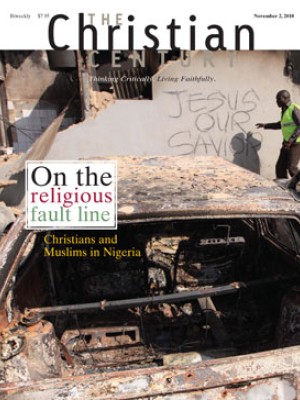A slow tsunami: Pakistan ravaged by flooding

The summertime floods have devastated Pakistan—inundating one-fifth of the country, displacing millions, destroying and altering landscapes. But in other ways the floods changed very little. The country was already facing a perilous humanitarian and social situation. The floods have led some to wonder whether there is a future for the country.
"The Pakistani nation does not exist now," said one Pakistani.
Some argue that possession of nuclear weapons guarantees that the world's sixth-largest country will not break apart. The international community generally and the U.S. in particular have too much at stake in Pakistan, in its neighbor Afghanistan and in southern Asia to allow the situation to deteriorate into full chaos. Others point out that predictions of Pakistan's demise have been made before and have been proven wrong. Still, the months ahead are going to be wrenching—a fact confirmed when I spent early September with Church World Service colleagues in northern Pakistan.
Read our latest issue or browse back issues.
My visit to the province of Khyber Pakhtunkhwa, formerly known as the North-West Frontier Province, offered obvious signs of overwhelming calamity as well as the more subtle signs of strain. Two hundred thousand homes were lost in Khyber Pakhtunkhwa, a region where literacy rates are low and where there is a long history of fighting between the Pakistani military and antigovernment militants, including the Taliban. Bridges and roads have been washed out, hospitals destroyed; humanitarian assistance is ferried by cables and pulleys across wide valleys.
Balakot, a city still trying to recover from a 2005 earthquake, was leveled. Hospital personnel stood in the rubble of their destroyed building and said the floods had effectively wiped out medical care for some 300,000 people. "All the valley depended on this hospital," facility director Zia Ulhaq said. "We need a hospital immediately."
Traveling with CWS medical personnel and food distribution teams in rural areas, I saw long lines of families waiting to see a doctor. Skin and eye ailments were common, as were complaints of diarrhea. Most striking, however, were the telltale symptoms of childhood malnutrition: darkened and sunken eyes, thinner-than-usual bodies. Children who were probably about ten years old were the height of much younger children. These are the long-term, unaddressed social problems that will be aggravated by the floods.
In some cases people had walked for eight hours to receive bags of rice, cooking oil and other items. They told about homes in isolated and mountainous villages that were washed out, and families that had been forced to band together and find shelter.
Mohammad Saghir, 31, walked eight miles for the aid given out near Dubair. The father of five daughters and two sons, he is helping support a brother, sister and his parents. Saghir said his family and fellow villagers of Dubair Payeen had been living in a vacated school and were trying their best to keep their spirits up during Ramadan. But they are uncertain of the future. How were they coping? "With assistance like this," Saghir said, pointing to a bag of rice.
Said Qamar's family includes eight children as well as four nieces and nephews. Qamar lost his entire plot of land in a flood and landslide—and with it, his family's livelihood. Qamar was agonizing over what to do: was his land salvageable? Could he make a go of it in the city? Pakistani humanitarian workers were not sure how realistic it was for Qamar, a farmer nearing 50, to start a new life in Karachi with such a large family.
Multiply this story times 20 million—the number of those estimated to be affected by the floods—and you have some idea of the scale of the problems in Pakistan. Pakistanis who were already experiencing malnutrition, poverty and lack of health care have had all of their problems compounded.
Humanitarian workers are worried about the effects of spiraling poverty on a desperate population. "A person can't see his or her children die of hunger," said one medical worker, warning that resulting frustration might urge Pakistanis toward militancy. "He'll put a [bomb] jacket on and blow himself up before seeing his children die of hunger."
The frustration is evident at all levels of society. "We're back to where we started 63 years ago," said Qamar Zaman, a medical coordinator for CWS, referring to the chaos of partition during Pakistan's 1947 independence. "The magnitude of this disaster is huge. After the [2005] earthquake and now the floods, it's just been blow after blow. This is a slow tsunami. It will kill people slowly."
Probably no government or humanitarian body anywhere could adequately respond to a disaster affecting 20 million people. While officials of the World Food Program said it did not appear that the floods would cause famine, it was clear that the country faces the loss of about a quarter of its crops as well as its food and grain stocks; the extensive destruction of its road, canal, irrigation and logistical systems; and the loss of at least one planting season, especially the all-important wheat crop.
"If farmers are unable to plant, a massive loss of food production in 2011 and possibly long-term food shortages could result," said Morosin Ernesto of the Swiss Agency for Development and Cooperation in Pakistan.
Luigi Damiani, representative of the Food and Agriculture Organization of the United Nations, noted one overlooked fact in the destruction: the loss of many livestock animals, often the only bankable wealth of the landless. "Those few animals are all they have," Damiani said.
"People have gone from surviving to begging, with no house, no jobs, no livelihood," said another humanitarian worker. "We are a cursed people, a cursed country."
"Pakistan has nuclear weapons," said another worker, "but it doesn't have enough electricity to light houses."






